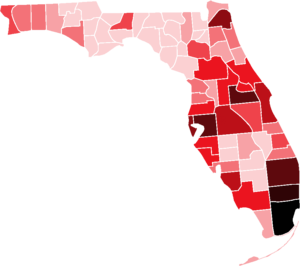List of counties in Florida facts for kids
Quick facts for kids Counties of Florida |
|
|---|---|
 |
|
| Location | State of Florida |
| Number | 67 |
| Populations | 7,706 (Liberty) – 2,686,867 (Miami-Dade) |
| Areas | 240 square miles (620 km2) (Union) – 2,034 square miles (5,270 km2) (Palm Beach) |
| Government | County government |
| Subdivisions | Communities |
Florida is a state in the United States. It has 67 areas called counties. These counties help the state government manage different regions. When Florida became a U.S. territory in 1821, it only had two counties: Escambia in the west and St. Johns in the east. These two were separated by the Suwannee River. All other counties were later created from these first two. Florida became the 27th U.S. state in 1845. The newest county, Gilchrist County, was formed in 1925 from part of Alachua County.
Counties in Florida are like smaller divisions of the state government. They have their own local governments. Since 1968, counties have been able to create their own rules, called charters. Most counties have a main town or city called a county seat. This is where the county government offices are located. Only two county seats in Florida are not official cities: Crawfordville in Wakulla County and East Naples in Collier County.
The names of Florida's counties tell stories about its history and culture. Some are named after important people from the Confederate era or Spanish explorers. This shows the influence of Spain on the state. Other names come from Christian saints, Native American places, or important U.S. leaders. Natural features like rivers, lakes, and plants are also common names for counties. For example, Miami-Dade County is partly named after Francis L. Dade, a U.S. Army major. Osceola County is named after Osceola, a leader of the Seminole people during the Second Seminole War.
The population numbers are based on estimates from 2023. Florida's total population is about 22.6 million people. This is a 5% increase since 2020. On average, a Florida county has about 337,474 people. Miami-Dade County is the most populated with over 2.6 million people. Liberty County is the least populated with about 7,706 people. The average land size of a county is about 805 square miles (2,085 km2). Collier County is the largest county by land area.
Exploring Florida's Counties
This section lists all the counties in Florida. You can see when each county was created and what it was formed from. You can also learn about how each county got its name.
| County |
FIPS code | County seat | Est. | Formed from | Etymology | Density |
Population | Area | Map |
|---|---|---|---|---|---|---|---|---|---|
| Alachua County | 001 | Gainesville | 1824 | Duval and St. Johns | From a Seminole-Creek word meaning "jug", likely for the sinkholes in the area | 327.22 | 285,994 | 874 sq mi (2,264 km2) |
 |
| Baker County | 003 | Macclenny | 1861 | New River | James McNair Baker (1821–1892), a senator and judge during the Civil War | 48.49 | 28,368 | 585 sq mi (1,515 km2) |
 |
| Bay County | 005 | Panama City | 1913 | Calhoun and Washington | St. Andrew's Bay, a key water feature in the county | 249.70 | 190,769 | 764 sq mi (1,979 km2) |
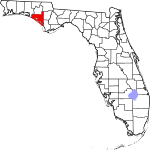 |
| Bradford County | 007 | Starke | 1858 | Columbia named New River until 1861 |
Richard Bradford, the first Florida officer to die in the Civil War | 95.08 | 27,858 | 293 sq mi (759 km2) |
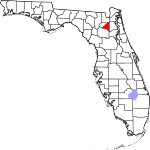 |
| Brevard County | 009 | Titusville | 1844 | Hillsborough and Mosquito named St. Lucie until 1855 |
Theodore Washington Brevard, an early settler and state comptroller | 632.59 | 643,979 | 1,018 sq mi (2,637 km2) |
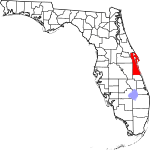 |
| Broward County | 011 | Fort Lauderdale | 1915 | Miami-Dade and Palm Beach | Napoleon Bonaparte Broward (1857–1910), a former governor of Florida | 1623.27 | 1,962,531 | 1,209 sq mi (3,131 km2) |
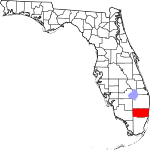 |
| Calhoun County | 013 | Blountstown | 1838 | Franklin, Jackson, and Washington | John C. Calhoun (1782–1850), a major politician from South Carolina | 23.76 | 13,470 | 567 sq mi (1,469 km2) |
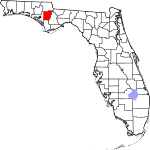 |
| Charlotte County | 015 | Punta Gorda | 1921 | DeSoto | Likely from the name of the Calusa, a Native American group | 297.02 | 206,134 | 694 sq mi (1,797 km2) |
 |
| Citrus County | 017 | Inverness | 1887 | Hernando | The county's many citrus fruit trees | 285.44 | 166,696 | 584 sq mi (1,513 km2) |
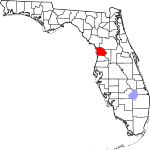 |
| Clay County | 019 | Green Cove Springs | 1858 | Duval | Henry Clay (1777–1852), a U.S. Secretary of State | 386.75 | 232,439 | 601 sq mi (1,557 km2) |
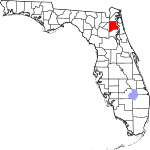 |
| Collier County | 021 | East Naples | 1923 | Lee | Barron Collier (1873–1939), a businessman who developed much of southern Florida | 199.56 | 404,310 | 2,026 sq mi (5,247 km2) |
 |
| Columbia County | 023 | Lake City | 1832 | Alachua | Christopher Columbus (c. 1451–1506), the famous explorer of the Americas | 91.67 | 73,063 | 797 sq mi (2,064 km2) |
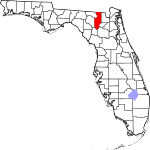 |
| DeSoto County | 027 | Arcadia | 1887 | Manatee | Hernando de Soto (c. 1496/1497–1542), a Spanish explorer | 56.48 | 35,979 | 637 sq mi (1,650 km2) |
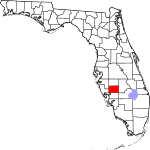 |
| Dixie County | 029 | Cross City | 1921 | Lafayette | Dixie, a common nickname for the Southern United States | 24.81 | 17,465 | 704 sq mi (1,823 km2) |
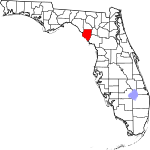 |
| Duval County | 031 | Jacksonville | 1822 | St. Johns | William Pope Duval (1784–1854), Florida Territory's first governor | 1331.81 | 1,030,822 | 774 sq mi (2,005 km2) |
 |
| Escambia County | 033 | Pensacola | 1821 | One of the two original counties | Its origin is debated; possibly from a Native American word for "clear water" | 492.36 | 326,928 | 664 sq mi (1,720 km2) |
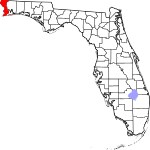 |
| Flagler County | 035 | Bunnell | 1917 | St. Johns and Volusia | Henry Morrison Flagler (1830–1913), who founded the Florida East Coast Railway | 271.01 | 131,439 | 485 sq mi (1,256 km2) |
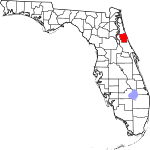 |
| Franklin County | 037 | Apalachicola | 1832 | Gadsden and Washington | Benjamin Franklin (1706–1790), one of the Founding Fathers of the U.S. | 23.58 | 12,594 | 534 sq mi (1,383 km2) |
 |
| Gadsden County | 039 | Quincy | 1823 | Jackson | James Gadsden (1788–1858), an American diplomat | 84.95 | 43,833 | 516 sq mi (1,336 km2) |
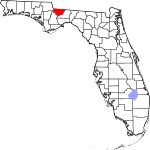 |
| Gilchrist County | 041 | Trenton | 1925 | Alachua | Albert W. Gilchrist (1858–1926), the 20th governor of Florida | 56.12 | 19,587 | 349 sq mi (904 km2) |
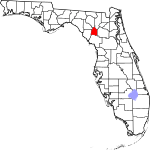 |
| Glades County | 043 | Moore Haven | 1921 | DeSoto | The Florida Everglades wetlands | 16.52 | 12,786 | 774 sq mi (2,005 km2) |
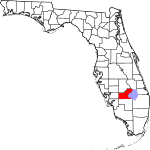 |
| Gulf County | 045 | Port St. Joe | 1925 | Calhoun | The Gulf of Mexico | 27.78 | 15,693 | 565 sq mi (1,463 km2) |
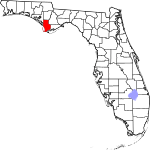 |
| Hamilton County | 047 | Jasper | 1827 | Jefferson | Alexander Hamilton (1757–1804), the first U.S. Secretary of the Treasury | 26.16 | 13,471 | 515 sq mi (1,334 km2) |
 |
| Hardee County | 049 | Wauchula | 1921 | DeSoto | Cary A. Hardee (1876–1957), governor of Florida when the county was created | 40.44 | 25,760 | 637 sq mi (1,650 km2) |
 |
| Hendry County | 051 | LaBelle | 1923 | Lee | Francis A. Hendry (1833–1917), an early Florida politician | 37.58 | 43,333 | 1,153 sq mi (2,986 km2) |
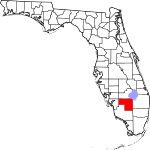 |
| Hernando County | 053 | Brooksville | 1843 | Alachua and Hillsborough named Benton from 1844 to 1850 |
Hernando de Soto (c. 1496/1497–1542), a Spanish explorer | 445.20 | 212,807 | 478 sq mi (1,238 km2) |
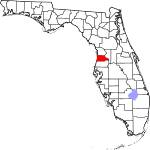 |
| Highlands County | 055 | Sebring | 1921 | DeSoto | Named for the county's hilly land | 104.68 | 107,614 | 1,028 sq mi (2,663 km2) |
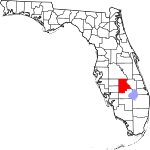 |
| Hillsborough County | 057 | Tampa | 1834 | Alachua | Wills Hill, Earl of Hillsborough (1718–1793), a former British Secretary of State | 1461.05 | 1,535,564 | 1,051 sq mi (2,722 km2) |
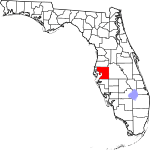 |
| Holmes County | 059 | Bonifay | 1848 | Jackson and Walton | Holmes Creek, a waterway forming the county's eastern border | 41.38 | 19,944 | 482 sq mi (1,248 km2) |
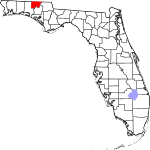 |
| Indian River County | 061 | Vero Beach | 1925 | St. Lucie | The Indian River Lagoon, which flows through the county | 337.56 | 169,795 | 503 sq mi (1,303 km2) |
 |
| Jackson County | 063 | Marianna | 1822 | Escambia | Andrew Jackson (1767–1845), the seventh U.S. President | 53.08 | 48,622 | 916 sq mi (2,372 km2) |
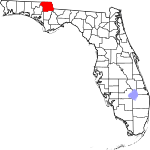 |
| Jefferson County | 065 | Monticello | 1827 | Leon | Thomas Jefferson (1743–1826), the third U.S. President | 25.84 | 15,450 | 598 sq mi (1,549 km2) |
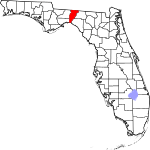 |
| Lafayette County | 067 | Mayo | 1856 | Madison | Marquis de La Fayette (1757–1834), a French general in the American Revolutionary War | 14.88 | 8,078 | 543 sq mi (1,406 km2) |
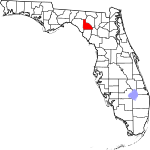 |
| Lake County | 069 | Tavares | 1887 | Orange and Sumter | Named for the many lakes in the region | 445.40 | 424,462 | 953 sq mi (2,468 km2) |
 |
| Lee County | 071 | Fort Myers | 1887 | Monroe | Robert E. Lee (1807–1870), a Confederate general during the Civil War | 1038.03 | 834,573 | 804 sq mi (2,082 km2) |
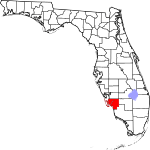 |
| Leon County | 073 | Tallahassee | 1824 | Gadsden | Juan Ponce de León (1474–1521), the Spanish explorer who named Florida | 445.15 | 296,913 | 667 sq mi (1,728 km2) |
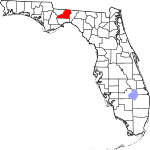 |
| Levy County | 075 | Bronson | 1845 | Alachua | David Levy Yulee (1810–1886), one of Florida's first U.S. Senators | 41.63 | 46,545 | 1,118 sq mi (2,896 km2) |
 |
| Liberty County | 077 | Bristol | 1855 | Gadsden | The patriotic idea of liberty | 9.22 | 7,706 | 836 sq mi (2,165 km2) |
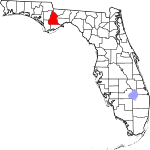 |
| Madison County | 079 | Madison | 1827 | Jefferson | James Madison (1751–1836), the fourth U.S. President | 26.76 | 18,519 | 692 sq mi (1,792 km2) |
 |
| Manatee County | 081 | Bradenton | 1855 | Hillsborough | The manatee, a sea cow native to Florida | 595.27 | 441,095 | 741 sq mi (1,919 km2) |
 |
| Marion County | 083 | Ocala | 1844 | Alachua, Hillsborough, and Mosquito | Francis Marion (c. 1732–1795), a military officer during the American Revolution | 259.63 | 409,959 | 1,579 sq mi (4,090 km2) |
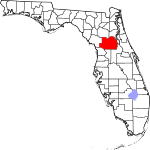 |
| Martin County | 085 | Stuart | 1925 | Palm Beach | John W. Martin (1884–1958), governor of Florida when the county was created | 293.73 | 163,315 | 556 sq mi (1,440 km2) |
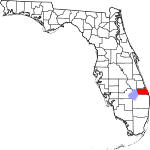 |
| Miami-Dade County | 086 | Miami | 1836 | Monroe named Dade until 1997 |
The City of Miami and Francis L. Dade (c. 1793–1835), a Major in the U.S. Army | 1380.71 | 2,686,867 | 1,946 sq mi (5,040 km2) |
 |
| Monroe County | 087 | Key West | 1823 | St. Johns | James Monroe (1758–1831), the fifth U.S. President | 80.86 | 80,614 | 997 sq mi (2,582 km2) |
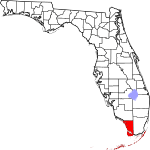 |
| Nassau County | 089 | Fernandina Beach | 1824 | Duval | Duchy of Nassau in Germany | 155.68 | 101,501 | 652 sq mi (1,689 km2) |
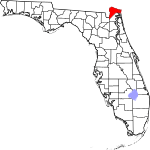 |
| Okaloosa County | 091 | Crestview | 1915 | Santa Rosa and Walton | A Choctaw word meaning "a pleasant place" or "beautiful place" | 233.40 | 218,464 | 936 sq mi (2,424 km2) |
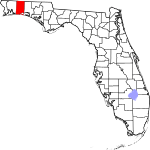 |
| Okeechobee County | 093 | Okeechobee | 1917 | Osceola and St. Lucie | Lake Okeechobee, from Native American words for "big water" | 53.52 | 41,427 | 774 sq mi (2,005 km2) |
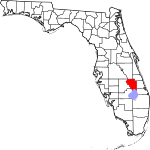 |
| Orange County | 095 | Orlando | 1824 | St. Johns named Mosquito until 1845 |
The fruit that was the county's main product | 1620.50 | 1,471,416 | 908 sq mi (2,352 km2) |
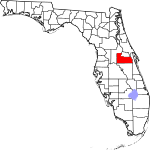 |
| Osceola County | 097 | Kissimmee | 1887 | Brevard and Orange | Osceola (1804–1838), a leader of the Seminole tribe | 331.15 | 437,784 | 1,322 sq mi (3,424 km2) |
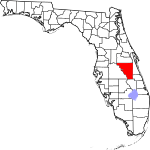 |
| Palm Beach County | 099 | West Palm Beach | 1909 | Miami Dade County | The county's many palm trees | 754.08 | 1,533,801 | 2,034 sq mi (5,268 km2) |
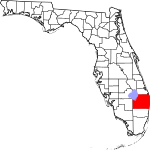 |
| Pasco County | 101 | Dade City | 1887 | Hernando | Samuel Pasco (1834–1917), a U.S. Senator | 849.66 | 632,996 | 745 sq mi (1,930 km2) |
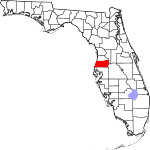 |
| Pinellas County | 103 | Clearwater | 1912 | Hillsborough | From the Spanish Punta Piñal, meaning "Point of Pines" | 3434.27 | 961,596 | 280 sq mi (725 km2) |
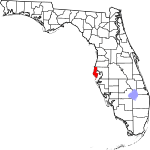 |
| Polk County | 105 | Bartow | 1861 | Brevard and Hillsborough | James K. Polk (1795–1849), the 11th U.S. President | 436.44 | 818,330 | 1,875 sq mi (4,856 km2) |
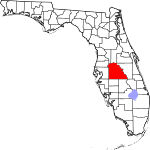 |
| Putnam County | 107 | Palatka | 1849 | Alachua and St. Johns | Benjamin A. Putnam (1801–1869), a soldier and legislator | 105.20 | 75,955 | 722 sq mi (1,870 km2) |
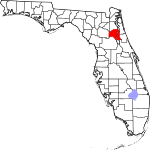 |
| St. Johns County | 109 | St. Augustine | 1821 | One of the two original counties | Named after the St. Johns River, which got its name from San Juan del Puerto | 525.63 | 320,110 | 609 sq mi (1,577 km2) |
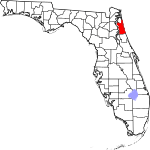 |
| St. Lucie County | 111 | Fort Pierce | 1905 | Brevard | Saint Lucy (283–304), a Christian saint | 653.12 | 373,586 | 572 sq mi (1,481 km2) |
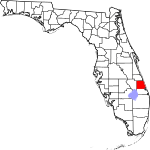 |
| Santa Rosa County | 113 | Milton | 1842 | Escambia | Santa Rosa Island, named for Saint Rosa de Viterbo (1235–1252), an Italian saint | 199.96 | 203,162 | 1,016 sq mi (2,631 km2) |
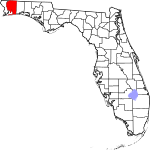 |
| Sarasota County | 115 | Sarasota | 1921 | Manatee | A Native American word for the area, with an unknown meaning | 819.95 | 469,013 | 572 sq mi (1,481 km2) |
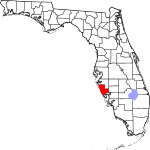 |
| Seminole County | 117 | Sanford | 1913 | Orange | The Seminole Native American tribe | 1572.31 | 484,271 | 308 sq mi (798 km2) |
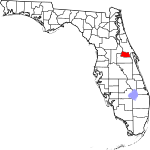 |
| Sumter County | 119 | Bushnell | 1853 | Marion | Thomas Sumter (1734–1832), a general in the American Revolution | 277.59 | 151,565 | 546 sq mi (1,414 km2) |
 |
| Suwannee County | 121 | Live Oak | 1858 | Columbia | The Suwannee River, a 266-mile long river in northern Florida | 67.05 | 46,130 | 688 sq mi (1,782 km2) |
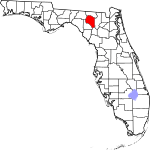 |
| Taylor County | 123 | Perry | 1856 | Madison | Zachary Taylor (1784–1850), the 12th U.S. President | 20.71 | 21,582 | 1,042 sq mi (2,699 km2) |
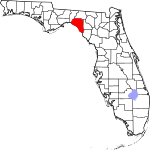 |
| Union County | 125 | Lake Butler | 1921 | Bradford | Named for the residents' shared desire to form a new county | 64.72 | 15,532 | 240 sq mi (622 km2) |
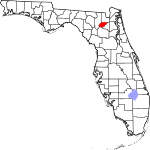 |
| Volusia County | 127 | DeLand | 1854 | Orange | The port of Volusia, whose name might mean "Land of the Euchees" | 533.78 | 590,357 | 1,106 sq mi (2,865 km2) |
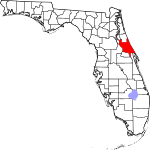 |
| Wakulla County | 129 | Crawfordville | 1843 | Leon | The Wakulla River, named from a Native American word with an unknown meaning | 60.05 | 36,449 | 607 sq mi (1,572 km2) |
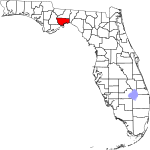 |
| Walton County | 131 | DeFuniak Springs | 1824 | Escambia and Jackson | George Walton, the first Secretary of Florida Territory | 81.62 | 86,354 | 1,058 sq mi (2,740 km2) |
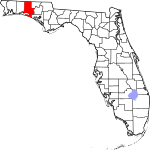 |
| Washington County | 133 | Chipley | 1825 | Jackson and Walton | George Washington (1732–1799), the first U.S. President | 44.14 | 25,602 | 580 sq mi (1,502 km2) |
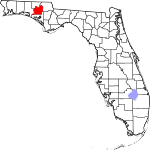 |
Counties That Changed Names
Five counties in Florida have changed their names over time. Most of these changes happened between 1845 and 1861, soon after Florida became a state. One recent change was in 1997, when Dade County became Miami-Dade County.
| County | Dates | Meaning of Name | What Happened |
|---|---|---|---|
| Benton County | 1844–1850 | Thomas Benton (1782–1858), a U.S. Senator who supported a law to move Native Americans | The county's original name was Hernando County, and it changed back in 1850 |
| Dade County | 1836–1997 | Francis L. Dade (c. 1793–1835), a Major in the U.S. Army | Changed to Miami-Dade County in 1997 to use the well-known name of Miami |
| Mosquito County | 1824–1845 | From the Spanish name for the coast, "Los Mosquitos" | This county had already given land to other counties. It was renamed Orange County in 1845. |
| New River County | 1858–1861 | The New River | Renamed to Bradford County in 1861 |
| St. Lucie County | 1844–1855 | Saint Lucy (283–304), a Christian saint | Renamed Brevard County in 1855 |
Ideas for New Counties
Sometimes, people suggest creating new counties in Florida. Here are a few ideas that have been proposed:
| County | When Proposed | Meaning of Name | Notes |
|---|---|---|---|
| Bloxham County | 1915 | William D. Bloxham (1835–1911), a former governor of Florida | The main town would have been Williston |
| Leigh Read County | 1842 | Leigh Read, a lawmaker | This was a suggested new name for Mosquito County |
| Miami County | 1947 | The City of Miami | This idea was for a combined city and county government |
| Ocean County | 1991 | The Atlantic Ocean | This was proposed for the areas known as the Jacksonville Beaches |
| Springs County | 2020 | The City of High Springs | This idea was to divide Alachua County |
See also
 In Spanish: Anexo:Condados de Florida para niños
In Spanish: Anexo:Condados de Florida para niños
- Florida
- List of municipalities in Florida
- List of former municipalities in Florida
- List of places in Florida
- List of county seats in Florida
- List of census-designated places in Florida


